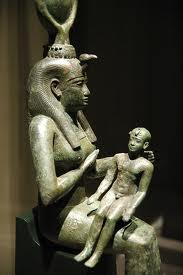Ceremony of Horus the Beloved
 |
Statute of Isis Suckling Horus; Bronze Karnak Late Period (664-332 B.C.) Egyptian Museum, Cairo |
The name Horus is a sort of catch-all for many deities (I'm not going to mention them all). One of the most famous would be Harseisis also called Heru-sa-Aset or Horus-son-of-Isis. It was he who was conceived after the death and resurrection of his father, Osiris. Heru became the patron of Lower Egypt owed in part to his battles with his uncle Set, in an attempt to not only avenge his father's murder, but to protect the people of Egypt and become the rightful ruler.
There are many myths regarding how the Upper and Lower Kingdoms were united. One, found in the Chester Beatty Papyrus I is the mythological story of “The Contendings of Horus and Seth” which describes the victory Heru had over Set (who was patron of the Upper Kingdom), as to who would take over Osiris' throne. Some scholars point to this victory as being the basis of a Father-Son line of kingship succession rather than the King's brother taking over upon his death.
 | |
| A relief of Horus and Geb from tomb KV14 in the Valley of the Kings. kairoinfo4u |
An older form of Horus, is that of Haroeris, Heru-ur or Horus the Elder. Heru-ur was worshipped in pre-Dynastic Upper Egypt. He was a creator god, the falcon who flew at the beginning of time. In this form, he is the brother of Osiris and Set, the second born of Geb and Nut's five children. Heru-ur was the consort of Hathor, and it is in this form, that I suspect this ceremony refers to.
This month, although not specifically mentioned by name on the Cauldrons' Calendar, features the Festival of the Beautiful Reunion. This is a long festival where Hathor journeys from Dendera to Edfu to marry Horus, her beloved. I'll cover this soon, it is coming up, so do watch out for it.
What today's ceremony entails, I have been unable to uncover. I could say that it is some sort of preparation for his upcoming nuptials, but that would be baseless speculation. If anyone has anything more concrete then please comment.
Skira
 |
| Erechtheum |
Skira is a three day long festival in the calendar of ancient Athens, which marks the end of the old year. It was such an important celebration that, in Athens, the last month of the year was called Skirophorion, after the festival. Skirophorion was the month of the final harvest of grain, so Skira was also a major agricultural festival.
To open the festival the priests of the Erechtheum (Erechtheus doubled as Poseidon in Athens - Poseidon Erechtheus) and Helios and the priestesses of Athena jointly took part in a procession beneath a canopy out of Athens to Skiron near Eleusis. Plutarch stated that one of the three 'sacred plowings' took place at Skiron, so it has been suggested that the end of the procession had some agricultural significance.
For the men, Skira meant they had to fast during the day, playing dice games to while away the time. For women it was something different. Skira, being about dissolution, seemed to flip social order. This was one of the few days women were allowed to leave the women's quarters and gather in public. They sacrificed and feasted and denied their husbands sex. Some sources state that they ate large quantities of garlic to keep the men away. Aristophanes' comedy Lysistrata (411 BCE), portrays the women as using the freedom of Skira to plot to stop male domination.
There was a also race during this festival to the shrine of Dionysos, where the participants were young men carrying vine branches. The victor would receive a drink made of wine, honey, cheese, grain and olive oil - all the fruits Athena had been asked to bless.
I'm not entirely sure that's a drink I would have wanted to win... or at least, taste.
No comments:
Post a Comment